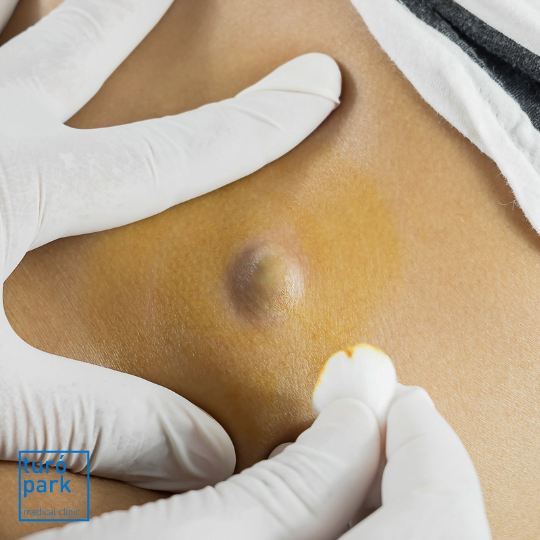Do you need skin surgery in Barcelona?
Dermatologists generally perform surgical procedures on the skin, including surgery for skin cancers and benign lesions, as well as certain cosmetic surgical procedures.
However, general surgeons are also skilled in dermatological surgery, including pilonidal cysts, lipomas, epidermal and sebaceous cysts, Verneuil's disease, plantar warts, and ingrown toenails.
At Turó Park Clinics, we are fortunate to have a team of dermatologists and skilled surgeons who will take care of you, whatever your need.
Fast track your treatment
To book an appointment or speak with one of our friendly team, please get in touch using the options below.

What are the indications for dermatological surgery?
General surgery in dermatology can be performed for different purposes:
- Establish a diagnosis by biopsy
- Removing benign or malignant skin tumours
- Improving the appearance of the skin by removing growths, discolorations, or the effects of aging
In all cases, it is your GP or dermatologist who will tell you whether surgery is useful in your case and if so, what type of operation should be performed.
Which dermatological conditions are treated by the general surgeon?
The dermatological pathologies most frequently treated by the general surgeon are the following:
These are cysts that form around a hair or short hair, most often in the intergluteal groove or near the navel.
These are benign tumors made up of fat 5 to 7 cm in diameter which form under the epidermis by the agglomeration of fat globules.
These benign skin tumours develop from the pilosebaceous follicles. A distinction is made between epidermal cysts, which are well-circumscribed, keratin-filled formations of very variable size, and sebaceous cysts, which contain an oily liquid or a compact, caseous substance with a poor odour.
This chronic inflammatory skin disease is manifested by the appearance of painful skin nodules, most often in the armpits, groin and/or buttocks.
Your health is our priority.
Our English-speaking general surgeons treat a wide variety of conditions & specialized surgical procedures.

How does dermatology surgery work?
In dermatological surgery, the surgeon usually removes the lesion followed by a direct suture. In cases where a direct suture is not possible, a local plasty may be performed, which consists of moving a flap of adjacent skin to cover the loss of substance.
The most common surgical techniques used are the following:
- Curettage with a sharp surgical instrument called a curette
- Surgical excision
- Cryosurgery with liquid nitrogen
- Laser
- Controlled micrographic surgery
These procedures are most often performed under local anaesthesia, without hospitalisation. In the case of a major procedure, general anaesthesia may be required as well as a day hospitalisation.
What are the possible complications of dermatological surgery?
Dermatological surgery is generally very safe and rarely leads to complications, most of which are not serious.
The most common complications include
- Haematomas
- Localized infection or abscess
- Skin necrosis
- Injury to surrounding nerves
- Abnormal wound healing
What is the healing process like after dermatological surgery?
At the beginning of the process, the scar is often red or pink, then it usually turns brown and becomes fibrous, before lightening and softening several weeks or even months after the operation.
In some cases, the scar evolves abnormally and can present an unsightly appearance. This is more often the case in patients with a high phototype, such as Hispanics, Asians, Indians or Africans.
In order to promote the healing process, it is recommended that the scar be kept out of the sun, that bathing be avoided, and that smoking and alcohol be avoided for at least one month so as not to impede the formation of the primary scar.
In the case of abnormal scarring, and in particular in the case of keloid scars or adhesions, treatment by a physiotherapist may also be considered in order to obtain both functional and aesthetic results.
Our multilingual general surgeons


